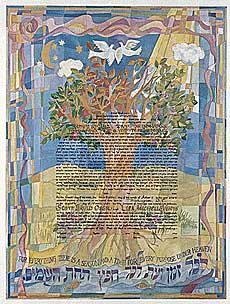 |
Words words words... Before the Ceremony |
Before the Ceremony
Tenaim
This is the formal engagement contract. A few hundred years ago, this was signed, sealed, and delivered a few months before the wedding. Nowadays, the Tenaim is signed at the wedding itself - mainly, because as a legal document, it would be a big problem if the engagement was to be broken. By signing it at the wedding, there is very little chance of anyone breaking the engagement. If you think about it, this makes for a pretty short engagement period - around 20 minutes.
After the Tenaim is signed, the two mothers-in-law break a
plate. This is to acklowledge that they are no longer responsible for
the sustenance of their children. Paige and David are then
responsible for each other. The fact that this is more or less
complete fiction escapes nobody involved - when we visit, they are
always going to try and feed us. It just comes with the territory.
The Ketubah
 Before the wedding ceremony can start there are two things that must
happen. First, the ketubah must be signed. The ketubah
is the marriage contract that all Jewish husbands are required to give
their brides. It spells out the groom's obligations to his bride: he
must provide her with food, clothing, various necessities, and he must
live with her as husband and wife. The language of the ketubah
is Aramaic (it was written in the second century B.C.E.) and hasn't
changed since.
Before the wedding ceremony can start there are two things that must
happen. First, the ketubah must be signed. The ketubah
is the marriage contract that all Jewish husbands are required to give
their brides. It spells out the groom's obligations to his bride: he
must provide her with food, clothing, various necessities, and he must
live with her as husband and wife. The language of the ketubah
is Aramaic (it was written in the second century B.C.E.) and hasn't
changed since.
There is a tradition of hiddur mitzvah - taking a commandment and making it beautiful - and so Paige and David have selected a painting called the "Tree of Life" by Sivia Katz. This painting shows a tree in all four seasons along with a quote from Ecclesiastes: "For everything there is a season, and a time for every purpose under heaven." (As it happens, this was also a rather nice song by The Byrds).
Like any contract, the ketubah must be witnessed. Rabbi George
Nudell from David's home shul in New Jersey and Rabbi Howard Addison
from Paige's home shul in Pennsylvania will be the witnesses for our
ketubah. Both men will have to pay close attention during the
ceremony to make sure David gives Paige the ring.
The Bedecken
Once the ketubah is signed, David will "check" his bride. This
custom comes from the biblical story of the sisters Rachel and Leah.
As the story goes, Jacob asked for Rachel's hand in marriage. Lavan,
Rachel's father, would only agree to the marriage if Jacob would work
for him for seven years. At the end of the seven years, Jacob was
thrilled to be marrying Rachel, but at the end of the ceremony, he
lifted the veil to find that Lavan had switched his daughters and he
had married Leah by accident. Jacob then had to work seven more years
in order to be able to marry the woman he loved. To prevent
accidentally marrying the wrong woman, David will check to see that
the woman in the fancy white dress is, in fact, Paige, and will place
the veil over her face himself. No skullduggery here, though since
Paige is an only child, I'm not quite sure who her father could
substitute in anyway.
| Wedding info || Jewish stuff || Visiting Philadelphia || Paige and David || Audience participation |